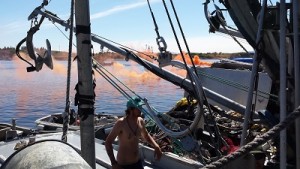On Saturday afternoon, fishermen and concerned Kodiak residents gathered at Pier II to protest the location and timing of the Navy Training in the Gulf of Alaska. The Sun’aq Tribe helped to organize the event with the help of skippers and crew members alike.
On board the Mythos, a voice comes on over the radio telling vessels to tie together in front of pier 2.
We make our way into a line, where we face the crowd of about 33 people lined up on the dock in front of their cars. Crewmembers hurry to raft up the boats. Once they are secured and the rush to avoid collision is over, I climb down to the deck and speak to Mythos crewmember Rolf Hanning.

Hanning is a newcomer to both Alaska and fishing and came out to take a stand alongside his skipper and crew.
“I don’t think it’s a very good idea to kill all the fish that this whole economy runs on, and beyond that, we know it’s bad for the environment, we know that they could do it somewhere else, it’s the United States government, they can bomb wherever they want. Why are they doing it right here? It doesn’t make any sense,” says Hanning.
Fisherman Chuck McWethy also thinks the Navy training could take place elsewhere.
“If they want to go blow up their bombs, they can figure out where there’s less sea life, where there’s less commercial product available for harvest that has a real, real good possibility of being affected by it,” says McWethy.
I hop from boat to boat to talk to protestors. Around me, crewmembers shoot flares into the sky, release orange smoke bombs, and honk their horns. Cars on the pier respond.
I end up on a vessel captained by McWethy’s son, Quinnan.
He says he just heard about the Navy training and doesn’t know much about it, but he’s there to support the fishing community.
“The only way we can actually achieve anything is if everyone gets together,” says McWethy. Whether it’s striking for prices of salmon or standing up to this, I know that everyone’s kinda coming together for something and I stand behind the fishing fleet and what they want to do.”
Wrapped up in the interview, we hear the shout that they’re cutting the boats loose a little too late. One of the fishermen offers me a skiff ride and delivers me to a ladder at pier 2. I climb my way up to the protest on land, where things are winding down.
Vice-Chair of the Sun’aq Tribe of Kodiak Council, John Reft, is among the crowd and says he has a personal history fishing in Portlock Bank, one of the areas where the Navy plans to train. He says King Crab comes in through there and the Navy could disturb the crab as well as other sea life.
“They’re gonna diminish the possible stocks when we’re trying to build this island back up for the King crab like it used to be,” says Reft. “You cannot take a chance with all those bombs and stuff that they’re going to use.”
Council Chair, Sophie Frets, is also at the protest, and says she saw a united front from the fishermen.
“They’re from totally different boat aspects, the trawlers, and the jiggers, and the salmon fishermen all together united to speak up and say this is not a game, that we need this to exist, so they got together in a way that I’m very proud that we were able to see it,” says Frets.
Frets says the Sun’aq Tribe put in a request to the United States Department of Defense for a formal consultation and hopes to get the Navy to listen to their concerns. She says the tribe is still waiting to hear back from officials.
Kayla Deroches is a reporter at KMXT in Kodiak.




